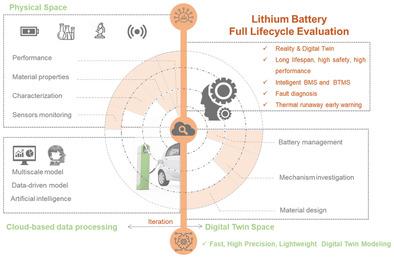当前位置:
X-MOL 学术
›
Adv. Energy Mater.
›
论文详情
Our official English website, www.x-mol.net, welcomes your
feedback! (Note: you will need to create a separate account there.)
Bridging Multiscale Characterization Technologies and Digital Modeling to Evaluate Lithium Battery Full Lifecycle
Advanced Energy Materials ( IF 24.4 ) Pub Date : 2022-06-15 , DOI: 10.1002/aenm.202200889 Xinhua Liu 1 , Lisheng Zhang 1 , Hanqing Yu 1 , Jianan Wang 2 , Junfu Li 3 , Kai Yang 2 , Yunlong Zhao 2 , Huizhi Wang 4 , Billy Wu 5 , Nigel P. Brandon 6 , Shichun Yang 1
Advanced Energy Materials ( IF 24.4 ) Pub Date : 2022-06-15 , DOI: 10.1002/aenm.202200889 Xinhua Liu 1 , Lisheng Zhang 1 , Hanqing Yu 1 , Jianan Wang 2 , Junfu Li 3 , Kai Yang 2 , Yunlong Zhao 2 , Huizhi Wang 4 , Billy Wu 5 , Nigel P. Brandon 6 , Shichun Yang 1
Affiliation

|
The safety, durability and power density of lithium-ion batteries (LIBs) are currently inadequate to satisfy the continuously growing demand of the emerging battery markets. Rapid progress has been made from material engineering to system design, combining experimental results and simulations to enhance LIB performance. Limited by spatial and temporal resolution, state-of-the-art advanced characterization techniques fail to fully reveal the complex multi-scale degradation mechanism in LIBs. Strengthening interaction and iteration between characterization and modeling improves the understanding of reaction mechanisms as well as design and management of LIBs. Herein, a seed cyber hierarchy and interactional network framework is demonstrated to evaluate the overall lifecycle of LIBs. The typical examples of bridging the characterization techniques and modeling are discussed. The critical parameters extracted from multi-scale characterization can serve as digital inputs for modeling. Furthermore, advanced computational techniques including cloud computing, big data, machine learning, and artificial intelligence can also promote the comprehensive understanding and precise control of the whole battery lifecycle. Digital twins techniques will be introduced enabling the real-time monitoring and control of LIBs, autonomous computer-assisted characterizations and intelligent manufacturing. It is anticipated that this work will provide a roadmap for further intensive research on developing high-performance LIBs and intelligent battery management.
中文翻译:

桥接多尺度表征技术和数字建模来评估锂电池的全生命周期
锂离子电池 (LIB) 的安全性、耐用性和功率密度目前不足以满足新兴电池市场不断增长的需求。从材料工程到系统设计取得了快速进展,结合实验结果和模拟来提高 LIB 性能。受空间和时间分辨率的限制,最先进的先进表征技术无法充分揭示 LIB 中复杂的多尺度退化机制。加强表征和建模之间的交互和迭代可以提高对反应机理的理解以及LIB的设计和管理。在这里,展示了种子网络层次结构和交互网络框架来评估 LIB 的整体生命周期。讨论了桥接表征技术和建模的典型示例。从多尺度表征中提取的关键参数可以用作建模的数字输入。此外,云计算、大数据、机器学习、人工智能等先进计算技术也可以促进对电池全生命周期的全面理解和精准控制。将引入数字孪生技术,以实现对 LIB、自主计算机辅助表征和智能制造的实时监控和控制。预计这项工作将为进一步深入研究开发高性能LIB和智能电池管理提供路线图。从多尺度表征中提取的关键参数可以用作建模的数字输入。此外,云计算、大数据、机器学习、人工智能等先进计算技术也可以促进对电池全生命周期的全面理解和精准控制。将引入数字孪生技术,以实现对 LIB、自主计算机辅助表征和智能制造的实时监控和控制。预计这项工作将为进一步深入研究开发高性能LIB和智能电池管理提供路线图。从多尺度表征中提取的关键参数可以用作建模的数字输入。此外,云计算、大数据、机器学习、人工智能等先进计算技术也可以促进对电池全生命周期的全面理解和精准控制。将引入数字孪生技术,以实现对 LIB、自主计算机辅助表征和智能制造的实时监控和控制。预计这项工作将为进一步深入研究开发高性能LIB和智能电池管理提供路线图。而人工智能还可以促进对整个电池生命周期的全面理解和精准控制。将引入数字孪生技术,以实现对 LIB、自主计算机辅助表征和智能制造的实时监控和控制。预计这项工作将为进一步深入研究开发高性能LIB和智能电池管理提供路线图。而人工智能还可以促进对整个电池生命周期的全面理解和精准控制。将引入数字孪生技术,以实现对 LIB、自主计算机辅助表征和智能制造的实时监控和控制。预计这项工作将为进一步深入研究开发高性能LIB和智能电池管理提供路线图。
更新日期:2022-06-15
中文翻译:

桥接多尺度表征技术和数字建模来评估锂电池的全生命周期
锂离子电池 (LIB) 的安全性、耐用性和功率密度目前不足以满足新兴电池市场不断增长的需求。从材料工程到系统设计取得了快速进展,结合实验结果和模拟来提高 LIB 性能。受空间和时间分辨率的限制,最先进的先进表征技术无法充分揭示 LIB 中复杂的多尺度退化机制。加强表征和建模之间的交互和迭代可以提高对反应机理的理解以及LIB的设计和管理。在这里,展示了种子网络层次结构和交互网络框架来评估 LIB 的整体生命周期。讨论了桥接表征技术和建模的典型示例。从多尺度表征中提取的关键参数可以用作建模的数字输入。此外,云计算、大数据、机器学习、人工智能等先进计算技术也可以促进对电池全生命周期的全面理解和精准控制。将引入数字孪生技术,以实现对 LIB、自主计算机辅助表征和智能制造的实时监控和控制。预计这项工作将为进一步深入研究开发高性能LIB和智能电池管理提供路线图。从多尺度表征中提取的关键参数可以用作建模的数字输入。此外,云计算、大数据、机器学习、人工智能等先进计算技术也可以促进对电池全生命周期的全面理解和精准控制。将引入数字孪生技术,以实现对 LIB、自主计算机辅助表征和智能制造的实时监控和控制。预计这项工作将为进一步深入研究开发高性能LIB和智能电池管理提供路线图。从多尺度表征中提取的关键参数可以用作建模的数字输入。此外,云计算、大数据、机器学习、人工智能等先进计算技术也可以促进对电池全生命周期的全面理解和精准控制。将引入数字孪生技术,以实现对 LIB、自主计算机辅助表征和智能制造的实时监控和控制。预计这项工作将为进一步深入研究开发高性能LIB和智能电池管理提供路线图。而人工智能还可以促进对整个电池生命周期的全面理解和精准控制。将引入数字孪生技术,以实现对 LIB、自主计算机辅助表征和智能制造的实时监控和控制。预计这项工作将为进一步深入研究开发高性能LIB和智能电池管理提供路线图。而人工智能还可以促进对整个电池生命周期的全面理解和精准控制。将引入数字孪生技术,以实现对 LIB、自主计算机辅助表征和智能制造的实时监控和控制。预计这项工作将为进一步深入研究开发高性能LIB和智能电池管理提供路线图。










































 京公网安备 11010802027423号
京公网安备 11010802027423号